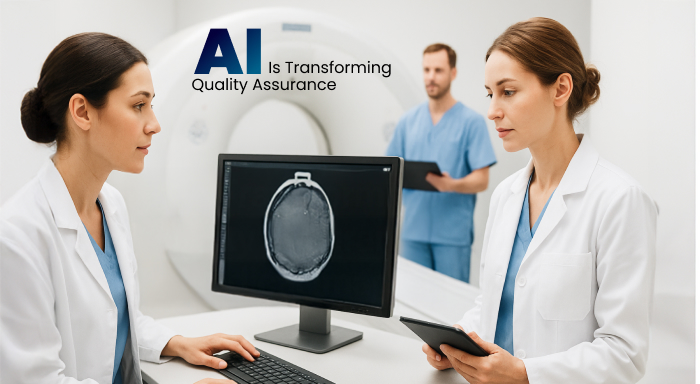Medical imaging departments handle large volumes of scans every day, part of the more than 3.6 billion imaging exams performed globally each year. Every image must be reviewed by staff to ensure clarity, accuracy, and safety.
This includes routine quality control inspections, phantom image review, and verifying that equipment is performing within established limits. These activities consume time and could not catch incremental performance changes.
Artificial intelligence can automate many of these checks. It can catch problems earlier and give consistent results. The intent is not to replace qualified personnel but to provide them with more accurate data so they can work more efficiently. This makes quality assurance continuous instead of periodic.
Let us observe how AI is being used to quality assurance in medical imaging, what advantages it holds, and the risks that have to be addressed.
QA vs. QC – Quick Explanation
Let’s clarify two often-confused terms.
Quality Assurance (QA) Maintaining imaging consistency and dependability, ensuring that scans consistently meet objectives like resolution and safety, is known as quality assurance, or QA.
Quality Control (QC) The routine technical work to ensure that MRI, CT, or X-ray systems are operating as intended is known as quality control, or QC. We're discussing things like radiation dose verification, equipment calibration, and phantom imaging.
Accrediting bodies such as the American College of Radiology require facilities, including those providing teleradiology solutions, to maintain documented QC procedures under the oversight of a medical physicist.
Artificial intelligence supports both QA and QC. It reduces manual work, improves consistency, and ensures every test result is recorded and retrievable.
How AI Is Revolutionizing QA in Medical Imaging
AI is already influencing many areas of healthcare, from diagnosis to workflow management. In medical imaging, these tools are being deployed directly into quality assurance, with the result being quicker issue detection, regular performance testing, and organized reporting.
Automated Phantom and Equipment QC
Conventionally, phantom image evaluation translates into manual examination or human reading of scan results to ensure uniformity, signal-to-noise ratio (SNR), geometry, and artifacts.
Artificial intelligence software now scans these phantom images automatically: computing metrics, comparing them against baseline performance, and detecting drift in real time. That leaves physicists spending a whole lot less time staring at numbers and more time responding to actionable alarms.
In 2023 research, it was demonstrated that deep learning models can assess MRI ACR phantom images with more than 80 percent accuracy for geometric distortion and spatial resolution detection.
Image Quality Scoring and Artifact Detection
Image quality may be inconsistent because of patient movement, equipment malfunction, or improper protocol settings. AI systems can mark images against established quality standards and identify specific artifacts such as motion blur, streaks, or truncation.
When interfaced to imaging workflow, the systems will notify personnel prior to the patient's departure from the scanner. The team can therefore repeat or modify the scan as required on the spot. The method minimizes repeat visits and ensures that diagnostically relevant images are acquired the first time around.
An analysis that appeared in European Radiology Experimental states that AI facilitates dose reduction, artifact elimination, noise suppression, and accelerated image reconstruction.
Optimization of Dose and Protocol
Dose of radiation in CT scanning should be adequate for diagnostic purposes but as low as possible for safety in patients. AI systems can track dose parameters like CTDIvol and DLP for every scan.
By comparing results at different sites and between scanners, and analyzing trends, AI can pick up on when doses are higher or lower than anticipated for a specific protocol. This is used to optimize protocols while not decreasing image quality. Eventually, departments can have more consistent doses and minimize patient exposure while preserving the necessary diagnostic performance.
Auditable and Structured QA Data
Data quality is commonly kept in spreadsheets, reports, or isolated notes, which can be difficult to find during audits. Output can be saved in structured formats by AI systems like DICOM Structured Reports. The formats are uniform and can be incorporated into PACS or QA dashboards.
This method leaves a permanent, searchable quality check record, image scores, and history of alerts. Audits are simplified because all the necessary evidence is held in one location and in an accreditation body-recognized format.
Continue Support and Review
As the imaging environment changes, AI performance can adapt as well. That's why continuous monitoring of things like frequency of alerts, false alarms, and accuracy is so crucial.
Checking those numbers on a regular basis allows teams to catch when the AI may be due for an update or retraining. AI tools also help ensure consistency by applying the same quality checks to everywhere.
Good governance involves having clear regulations for checking AI results, acting when required, and maintaining proper records. This maintains conformity and establishes trust in the system.
How to Add AI to QA Without Disrupting Workflow
Consider beginning with a single AI tool that enhances a routine task. You decide on something impactful and doable. It is connected to your existing system. You quantify outcomes. You keep using your expertise to check outcomes. Then you expand.
Here are clear steps:
- Select a limited starting scope. Begin with one or two use cases such as MRI phantom analysis or CT dose monitoring.
- Integrate with existing systems. Choose AI tools built with best practices in medical software development that can send results directly to your PACS, worklists, or QA dashboards to avoid manual transfers.
- Require standardized output. Use formats like DICOM Structured Reports so data is consistent, interoperable, and ready for audits.
- Set measurable goals. Examples include reducing review time, decreasing repeat scans, or lowering outlier dose events. Begin with a clear baseline and then compare future improvements later.
- Maintain human oversight. Make sure a skilled staff member reviews AI outputs before taking any action.
- Plan for ongoing performance review. Regularly assess false positive rates, accuracy, and consistency across scanners or sites.
By taking these actions, AI is transformed from an experimental tool into a useful supplement to QA. They guarantee that credibility increases with use and protect workflows.
Risks and How to Avoid Them
AI brings capabilities, but challenges require careful handling. Consider them one by one.
- Over-reliance on automation. Always validate AI output before making clinical or operational changes.
- Excessive alerts. To ensure that alerts concentrate on issues that can be addressed, modify the thresholds.
- Low site-to-site transferability. Validate AI models on each scanner and protocol before full deployment.
- Unstructured or inaccessible data. Store results in standardized formats that can be retrieved for review or audits.
- Lack of integration. Instead of developing new procedures, make sure the AI integrates into current workflows.
This method guarantees AI supports quality assurance without overburdening personnel or sacrificing precision.
Final Thoughts
Artificial intelligence is optimizing medical imaging quality assurance and making it standardized. It can automate repeated testing, detect faults in real time, and provide formatted records for audit.
The secret is to introduce it under monitored conditions, with predetermined aims and good oversight. Used appropriately with proper standards and monitoring, AI becomes a reliable element of QA protocol, aiding staff to produce accurate and safe images for each patient.




%201.png)

%201.png)

%201.png)

